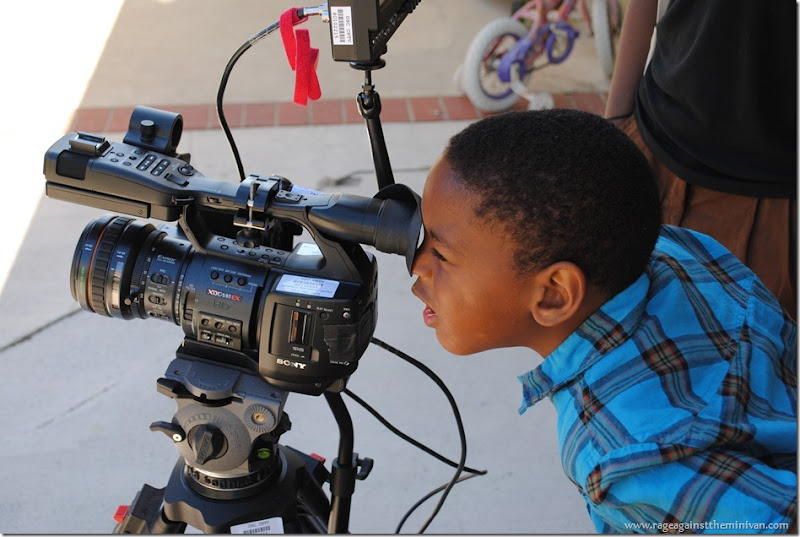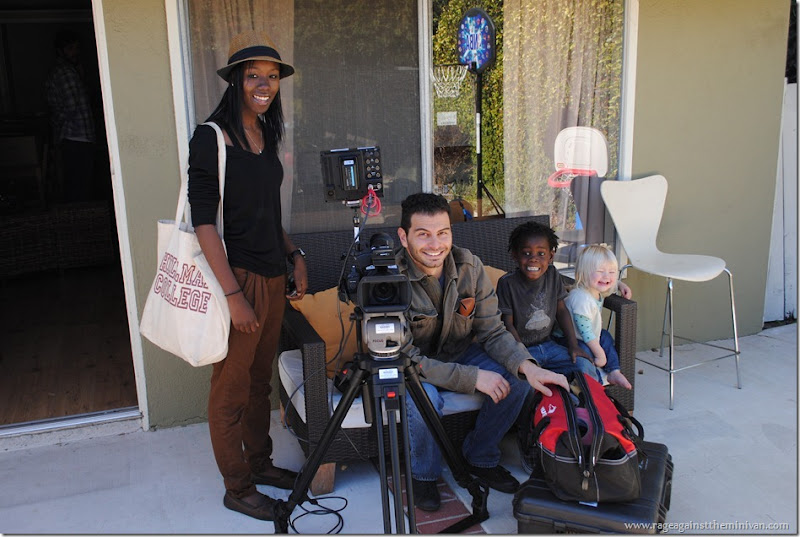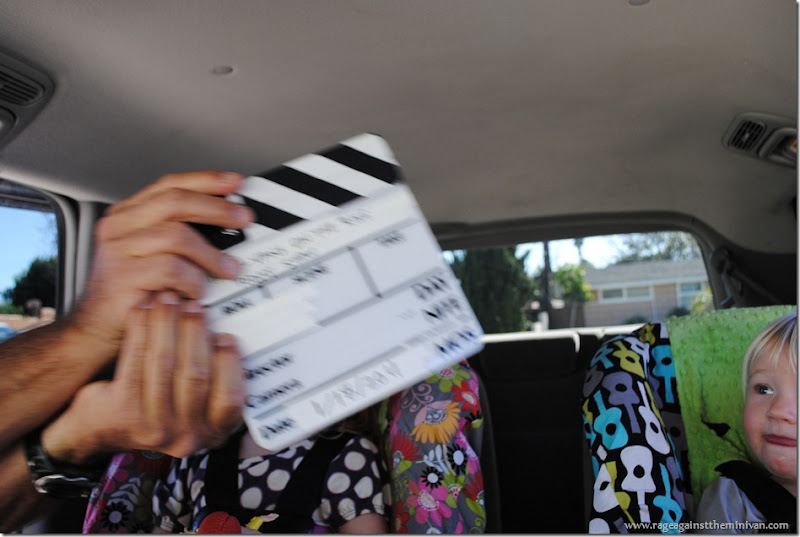About a year ago I was contacted by a graduate film student at USC who was working on a documentary for her final thesis. Her chosen subject was transracial adoption, and she wanted to know if they could follow our family around for a few days and interview us. I was a little uncertain at first . . . with the working title “Color Blind”, I was apprehensive as to how we might be portrayed. (You can read about my issue with the concept of colorblindness here). At the same time, I often feel that it’s the most awful adoptive parents who tend to get the most press (i.e. the lady who returned her kid to Russia), so I figured if we could be a normal, relatable adoptive family in the film, that it could be a good thing. 

 The filming ended up being a good experience. We got to attend a screening of the film in LA last year and I really liked it. I’m a documentary nerd, so I appreciated that the filmmaker Khadija Diakite wasn’t too heavy-handed in presenting transracial adoption as either “all good” or “all bad”. She followed another family as well, and we all talked about race and adoption issues pretty frankly in the film. She also interviewed an adult adoptee who advocates against transracial adoption. It made for an interesting moment in the film, because while she was saying that kids should be left in their culture of birth even if it means growing up in group settings, it cut to me talking about how most orphaned children aren’t that familiar with their culture of birth while living within the walls of an orphanage. (I’ve written about how I believe that “orphanage culture” is the prevailing culture for children in group settings in this post). There was another point where she argued that “the jury is still out” as to whether growing up in a family setting is more important than growing up within a person’s country of birth, and there was an audible groan from the audience . . . which was interesting, given that most of the audience was there to watch a documentary about fast-pitch softball. I think that even for those not familiar with adoption, this idea of culture trumping family just seems wrong. Not to mention, the jury really isn’t out. I think you would be hard pressed to find someone with expertise in child development who would say that the bonds of attachment and nurture for a child fall in second place after the maintenance of cultural ties. (Not that I think cultural identity is not important, mind you. I just don’t think it should come at the expense of family). The documentary was being shown again last weekend, at the The Alliance for the Study of Adoption and Culture. Mark and I were asked to sit in on a panel about the film, along with the director and the other couple featured in the movie. We went up a day early so we could attend some of the other conference sessions. It was a fascinating conference and really different from any adoption conference I’ve attended in the past. I really appreciated the fact that there were no adoption agencies present. I feel like this lent to a more honest conversation. Adult adoptees were well represented, and there was a focus on academic research that I appreciated as a former researcher. At the same time, as is often true with academia, sometimes I felt like we were talking about so much theory that we were losing site of the very human aspects of adoption and family. Many of the sessions were extremely though-provoking. It was nice to be away from the kids and to process all of it with Mark. I’ll hopefully have some time to download some more thoughts this week, because I would love to talk more about the intersection of feminism and adoption, which was a major and slightly controversial theme at the conference, as well as the idea of narrative choice in adoption identity. I was a bit apprehensive about the panel we signed up to do, because a few days prior I found out that Lisa Marie Rollins was going to be our moderator. Lisa Marie writes the blog A Birth Project, which I’ve read for several years. She’s passionate about educating parents and supporting kids in transracial adoption,, and even though we don’t agree on everything I’ve always respected her writing. However, shortly after the earthquake Lisa Marie and some other activists authored a joint statement in regards to the orphan situation in Haiti. At the surface, I agreed with the major premise:
The filming ended up being a good experience. We got to attend a screening of the film in LA last year and I really liked it. I’m a documentary nerd, so I appreciated that the filmmaker Khadija Diakite wasn’t too heavy-handed in presenting transracial adoption as either “all good” or “all bad”. She followed another family as well, and we all talked about race and adoption issues pretty frankly in the film. She also interviewed an adult adoptee who advocates against transracial adoption. It made for an interesting moment in the film, because while she was saying that kids should be left in their culture of birth even if it means growing up in group settings, it cut to me talking about how most orphaned children aren’t that familiar with their culture of birth while living within the walls of an orphanage. (I’ve written about how I believe that “orphanage culture” is the prevailing culture for children in group settings in this post). There was another point where she argued that “the jury is still out” as to whether growing up in a family setting is more important than growing up within a person’s country of birth, and there was an audible groan from the audience . . . which was interesting, given that most of the audience was there to watch a documentary about fast-pitch softball. I think that even for those not familiar with adoption, this idea of culture trumping family just seems wrong. Not to mention, the jury really isn’t out. I think you would be hard pressed to find someone with expertise in child development who would say that the bonds of attachment and nurture for a child fall in second place after the maintenance of cultural ties. (Not that I think cultural identity is not important, mind you. I just don’t think it should come at the expense of family). The documentary was being shown again last weekend, at the The Alliance for the Study of Adoption and Culture. Mark and I were asked to sit in on a panel about the film, along with the director and the other couple featured in the movie. We went up a day early so we could attend some of the other conference sessions. It was a fascinating conference and really different from any adoption conference I’ve attended in the past. I really appreciated the fact that there were no adoption agencies present. I feel like this lent to a more honest conversation. Adult adoptees were well represented, and there was a focus on academic research that I appreciated as a former researcher. At the same time, as is often true with academia, sometimes I felt like we were talking about so much theory that we were losing site of the very human aspects of adoption and family. Many of the sessions were extremely though-provoking. It was nice to be away from the kids and to process all of it with Mark. I’ll hopefully have some time to download some more thoughts this week, because I would love to talk more about the intersection of feminism and adoption, which was a major and slightly controversial theme at the conference, as well as the idea of narrative choice in adoption identity. I was a bit apprehensive about the panel we signed up to do, because a few days prior I found out that Lisa Marie Rollins was going to be our moderator. Lisa Marie writes the blog A Birth Project, which I’ve read for several years. She’s passionate about educating parents and supporting kids in transracial adoption,, and even though we don’t agree on everything I’ve always respected her writing. However, shortly after the earthquake Lisa Marie and some other activists authored a joint statement in regards to the orphan situation in Haiti. At the surface, I agreed with the major premise:
“Removing children from Haiti without proper documentation and without proper reunification efforts is a violation of their basic human rights and leaves any family members who may be searching for them with no recourse.”
Okay, yeah. Totally. I think most everyone agreed that reunification efforts were priority #1 for any child who was found to be unsupervised after the earthquake. While there were some people (and even celebrities) expressing their desire to run in and rescue an orphan, no one in power was actually proposing that children orphaned by the earthquake be shuttled out of the country immediately. So that part I supported. But then there was this little tidbit:
“Western and Northern desire for ownership of Haitian children directly contributes to the destruction of existing family and community structures in Haiti. This individualistic desire is supported by the historical and global anti-African sentiment which negates the validity of black mothers and fathers and condones the separation of black children from their families, cultures, and countries of origin.”
Um . . . okay. While I suppose it’s possible that there are some people who sign up for adoption out of some anti-African motivation, I don’t think that’s what drove most of us to that decision. Also . . . in an ethical adoption, it’s not adoptive parents who separate a child from their family – that already happened. I don’t know any adoptive parent who wanted to take a child away from willing parents, black, white, or otherwise. That part was cringe-worthy. But here’s the part of their statement that gave me a record-scratch moment:
“Immediate removal of traumatized children for adoption—including children whose adoptions were finalized prior to the quake— compounds their trauma, and denies their right to mourn and heal with the support of their community.”
So – this wasn’t just about making sure earthquake orphans had proper reunification efforts. This was about halting adoptions in general . . . even for kids whose adoption were final . . . even for kids with everything but a signature separating them from orphanage life and a loving family, kids who had waited two or three years, kids like Kembe, sleeping in a driveway while an understaffed orphanage tried to make due while dealing with injuries, crumbled walls, aftershocks, death of friends, food shortages, and looting. Kids who weren’t at great orphanages like Kembe’s who were left to fend for themselves while the orphanage staff went to care for their own families. Kids who were sleeping like sardines in the back of trucks or on tarps in the hot sun. Let’s take a look at some of the days after the earthquake to see what mourning and healing “with the support of their community” looked like for orphans in an earthquake-ravaged third world country:  I’m sure these kids are comforted to sleep in the knowledge that they are in no threat of losing their native language.
I’m sure these kids are comforted to sleep in the knowledge that they are in no threat of losing their native language.  My son is sleeping in the photo above, in the driveway of his orphanage. You can imagine the kind of mama-bear feelings this statement evoked in me, after experiencing the earthquake and the aftermath and having to leave my own kid in Haiti. Hearing there was a group of people fighting to leave there was infuriating. And finally:
My son is sleeping in the photo above, in the driveway of his orphanage. You can imagine the kind of mama-bear feelings this statement evoked in me, after experiencing the earthquake and the aftermath and having to leave my own kid in Haiti. Hearing there was a group of people fighting to leave there was infuriating. And finally:
All adoptions from Haiti must be stopped and all efforts to help children be refocused on giving aid to organizations working toward family reunification and caring for children in their own communities.
This is the point at which I felt like the statement was less about ensuring reunification for earthquake survivors (which was always, always the goal of those in power in Haiti) and more about taking a tragedy and making it a talking point to stop current adoptions. It felt opportunistic, and I was angry. Angry for the parents who were scared to death for their kids, angry for the kids they would leave there under some illusions of idyllic cultural community mourning, and angry for the new orphans who were denied a spot in a safe orphanage because kids who were already legally adopted (or very close) couldn’t leave because of red tape. I should add that, despite circulation amongst a circle of adoption blogs, that this particular statement did not shut down adoption from Haiti. It was through a joint agreement between the US and Haitian governments that allowed a provision for kids nearing the end of the adoption process to enter the US to live while their adoptions were finalized. This did not fast-track their adoptions, nor did it apply to children orphaned by the earthquake. But it did allow about 1000 waiting children to join their permanent families as Haitian orphanages began to recover and care for new orphans. So . . . I was a bit disconcerted when I learned that one of the biggest proponents of this statement was going to be on the panel. I knew I had talked specifically and critically about this statement during the filmmaking, and couldn’t remember if it had made it into the film or not. I was imagining this turning into a big debate between Lisa and I. I wondered how I would keep my composure if it came up. I wondered if she was going to use my family as an illustration – if some nuanced interaction between us in the film would become grist for an agenda . . . proof of the ills of transracial adoption. As it turns out, none of that happened. The part I was worried about didn’t even make it into the film. My beef with the Adoptee Statement notwithstanding, Lisa Marie was lovely and smart and funny. She asked great questions and gave great feedback and I thought the panel went really well. It was a reminder to me that, while some of us may come to different conclusions about transracial adoption, there is so much in the middle where we can agree. We both think it’s vitally important for parents to understand the unique needs of a child living in a culturally and/or ethnically different family, and we both see that, in transracial adoption, culture and language can be a collateral loss in the forming of a permanent family. I get that some people have come to the conclusion that this loss is too great a cost, but my opinion is that for children with no other options, having a permanent family will create a foundation from which a child can explore and build on every aspect of their identity. This conference was very stretching for me, and I continue to believe that adoption needs reform and that poverty should not be a barrier to keeping a family together. But I also remain steadfast in believing that the greatest need for every child is to be raised by a loving parent. By the way, the documentary Color Blind has a facebook page that you can follow to see if there is a screening near you. It will be at the Mixed Roots Festival in Los Angeles this summer. I’ll leave you with a description and a couple screen shots from the film:
Whether it is walking down the street, or on the cover of a magazine, a black child with a white parent elicits a response. Approximately forty percent of adoptions in the United States are transracial- and international adoptees are the fasting growing group. Often, adoptees live a political existence, as many have strong political opinions on transracial adoption. Color Blind looks at how two different white families who adopted from Haiti are dealing with race and identity. One family has recently moved to an African-American community . The other family has two biological daughters and an adopted African-American son and recently adopted their fourth child from Haiti. Will they be up to the challenge of raising self-identified black men? And, finally, we hear from an adult Korean Adoptee about some of the cultural problems international adoption raises. Going beyond the headlines and the image, Color Blind asks the question: how do families that adopt children outside of their race navigate culture and race?
![222097_210635838956192_210507635635679_766104_6687743_n[1] 222097_210635838956192_210507635635679_766104_6687743_n[1]](http://lh3.ggpht.com/-bFejzDfM9Iw/T3qLZIvUwsI/AAAAAAAAQbo/xmnCERU8f4w/222097_210635838956192_210507635635679_766104_6687743_n%25255B1%25255D_thumb%25255B4%25255D.jpg?imgmax=800)
![224817_210635912289518_210507635635679_766106_2082525_n[1] 224817_210635912289518_210507635635679_766106_2082525_n[1]](http://lh3.ggpht.com/-bybNVovz_8o/T3qLbfT_XPI/AAAAAAAAQb4/FxvG5R0o9tg/224817_210635912289518_210507635635679_766106_2082525_n%25255B1%25255D_thumb%25255B4%25255D.jpg?imgmax=800)
![324904_281220908564351_210507635635679_1076046_364860940_o[1] 324904_281220908564351_210507635635679_1076046_364860940_o[1]](http://lh3.ggpht.com/-ARdBKUYPYwU/T3qLee4_QNI/AAAAAAAAQcI/sU0wh3gbPkY/324904_281220908564351_210507635635679_1076046_364860940_o%25255B1%25255D_thumb%25255B6%25255D.jpg?imgmax=800)
